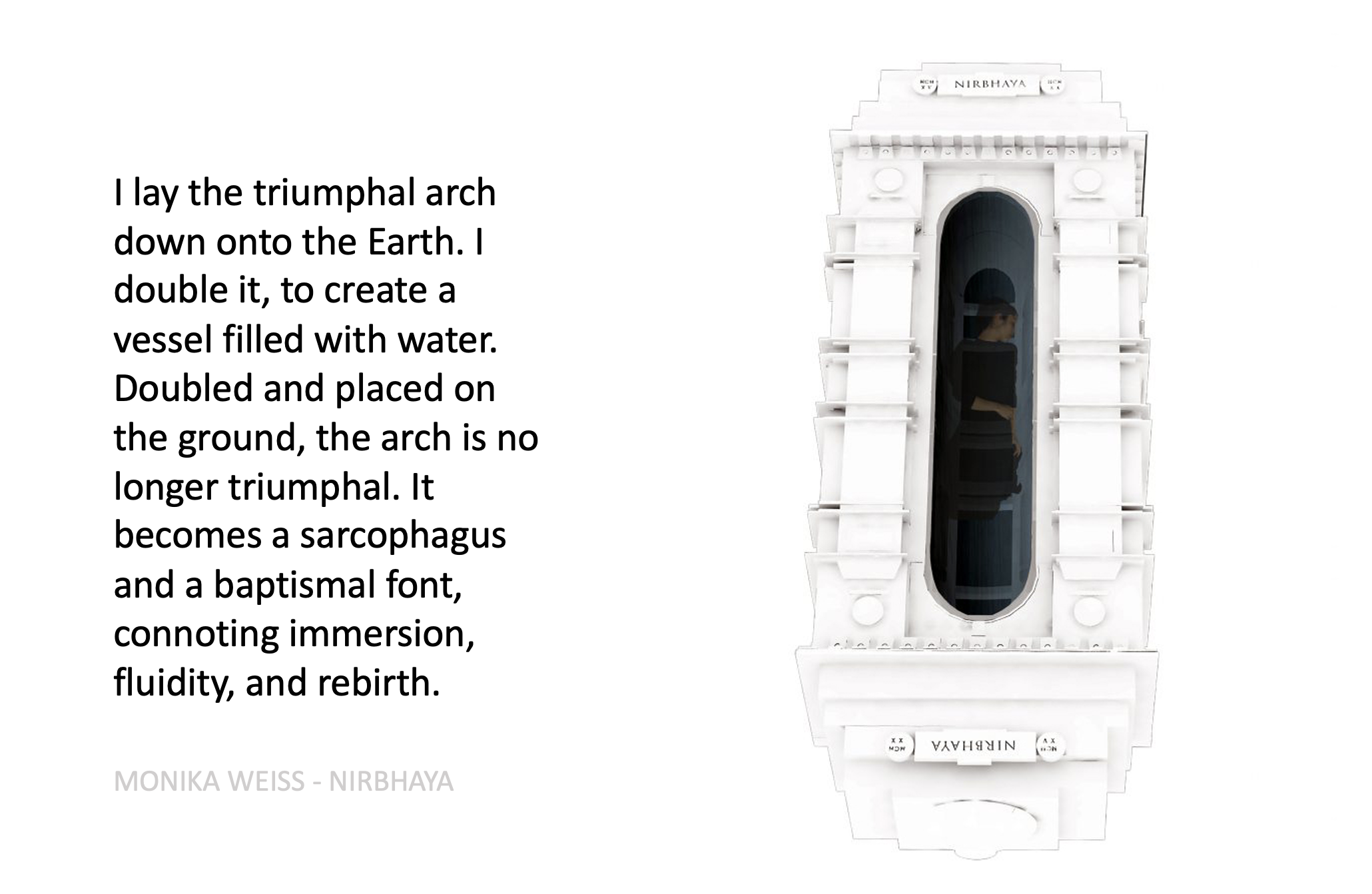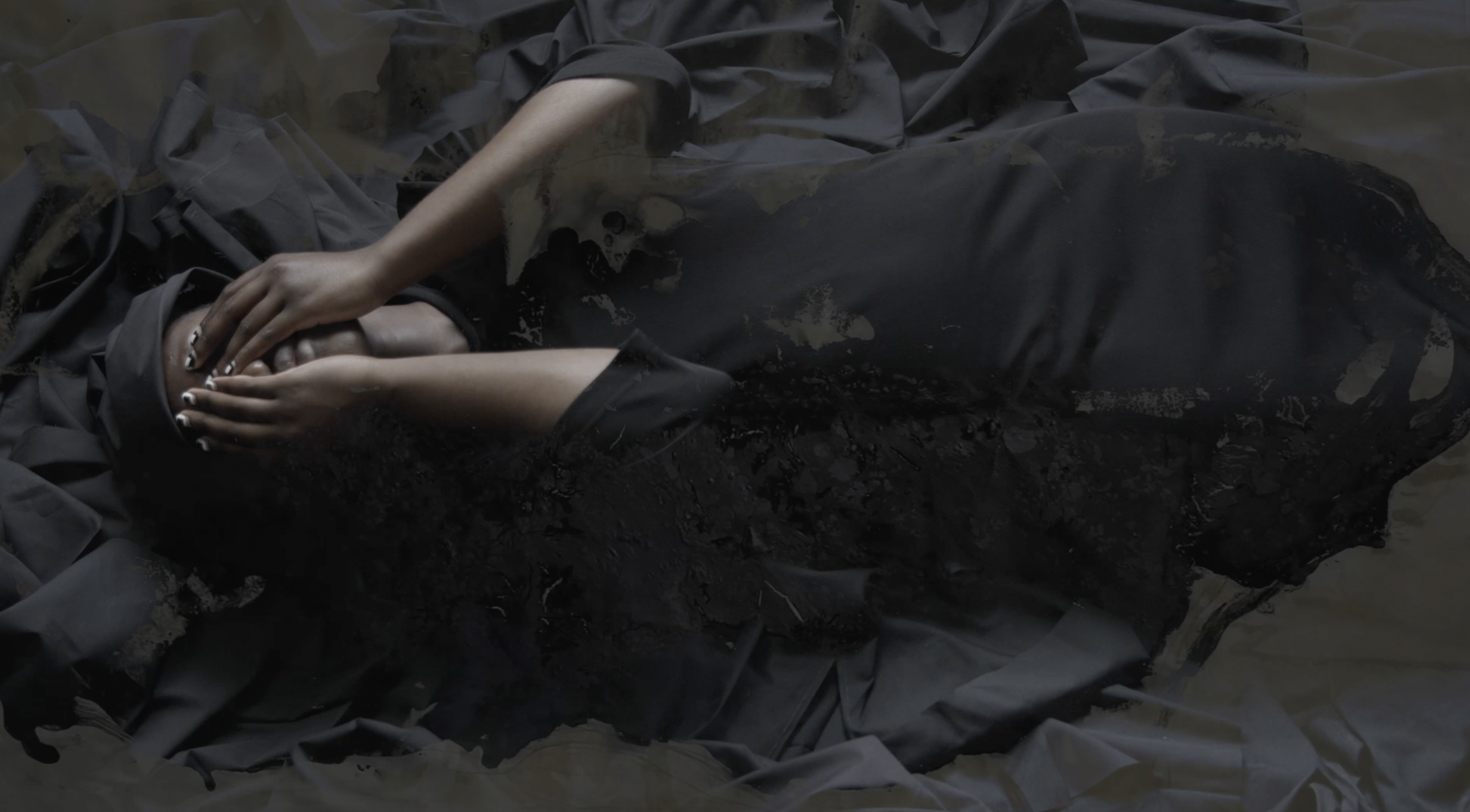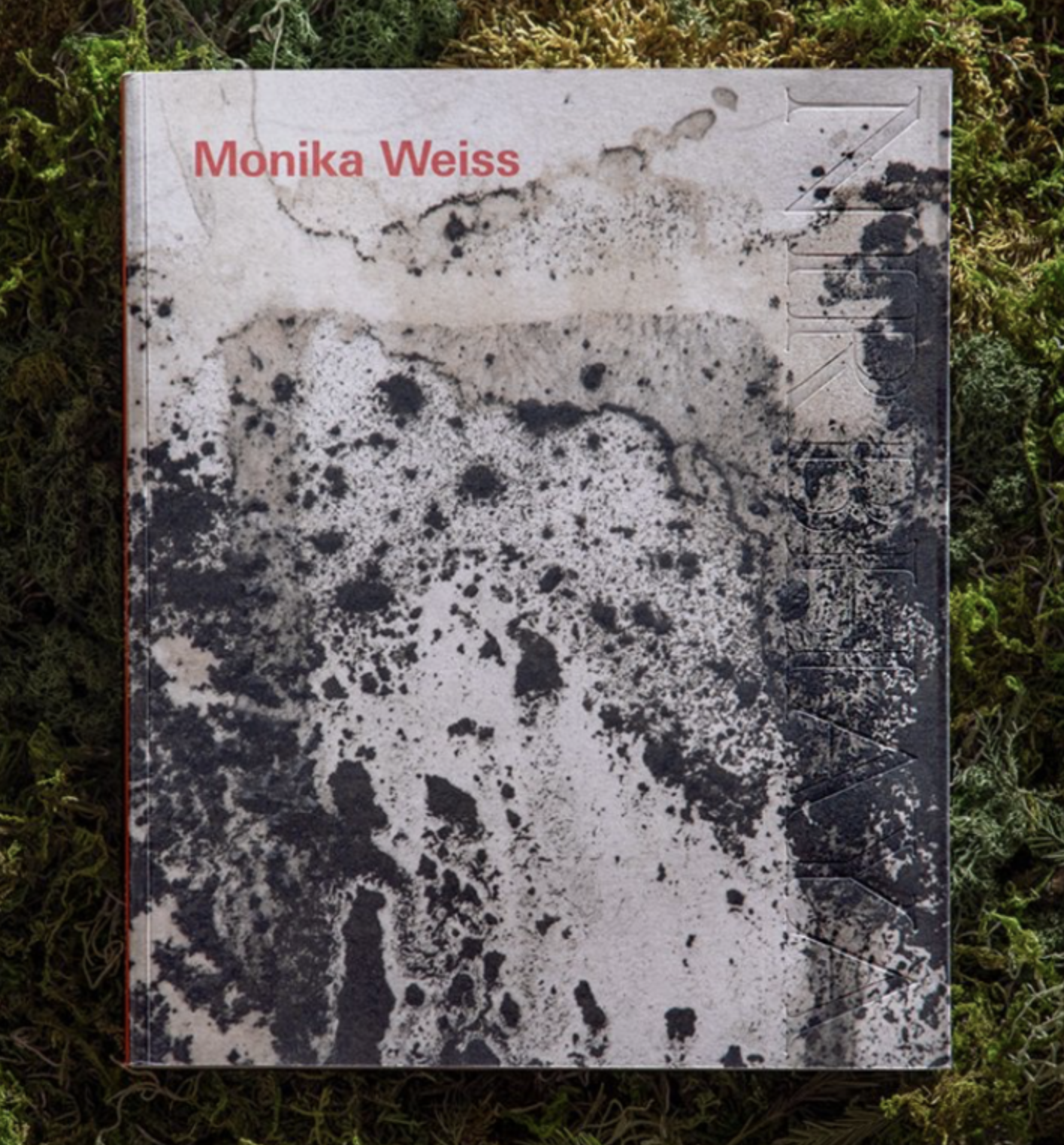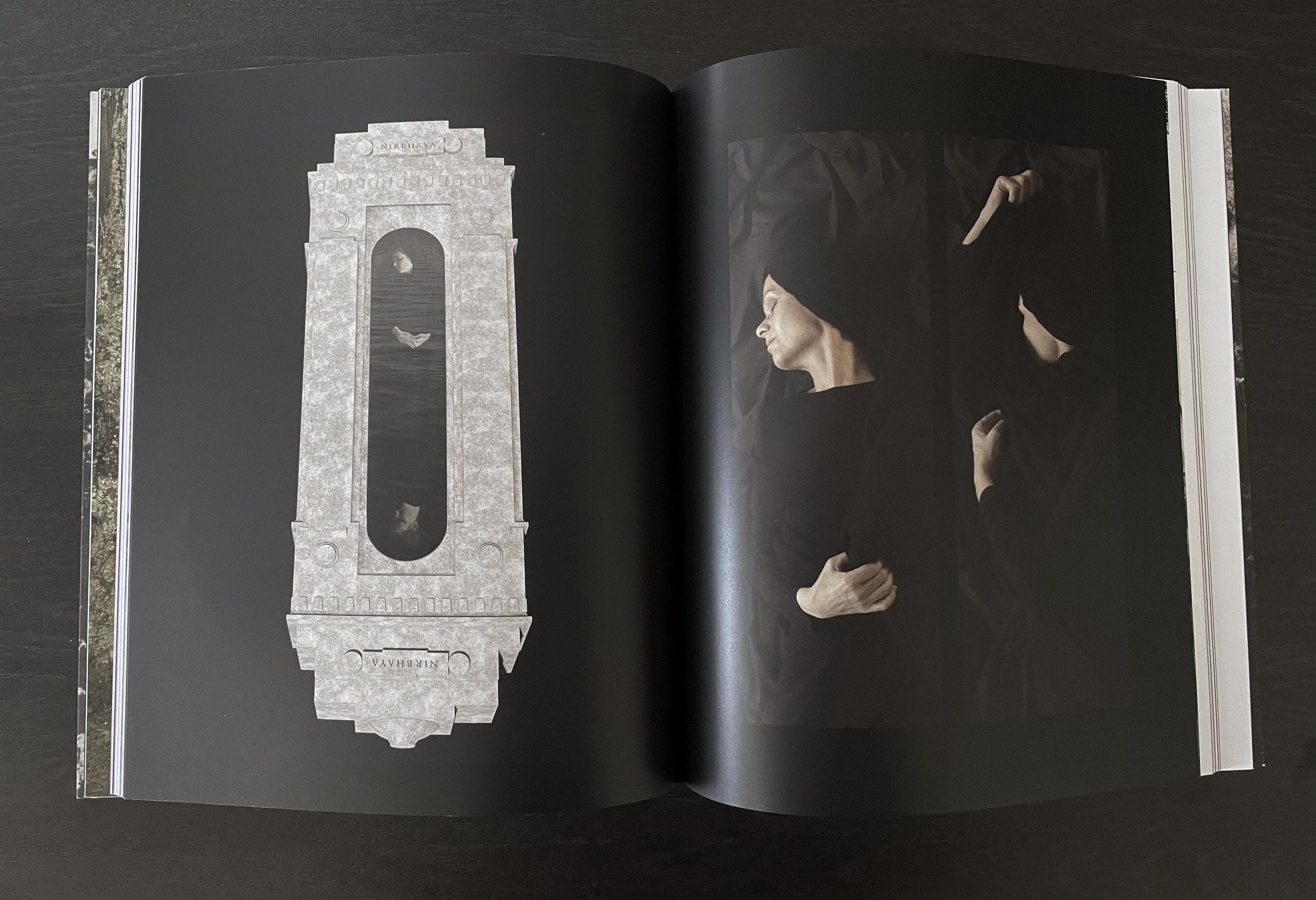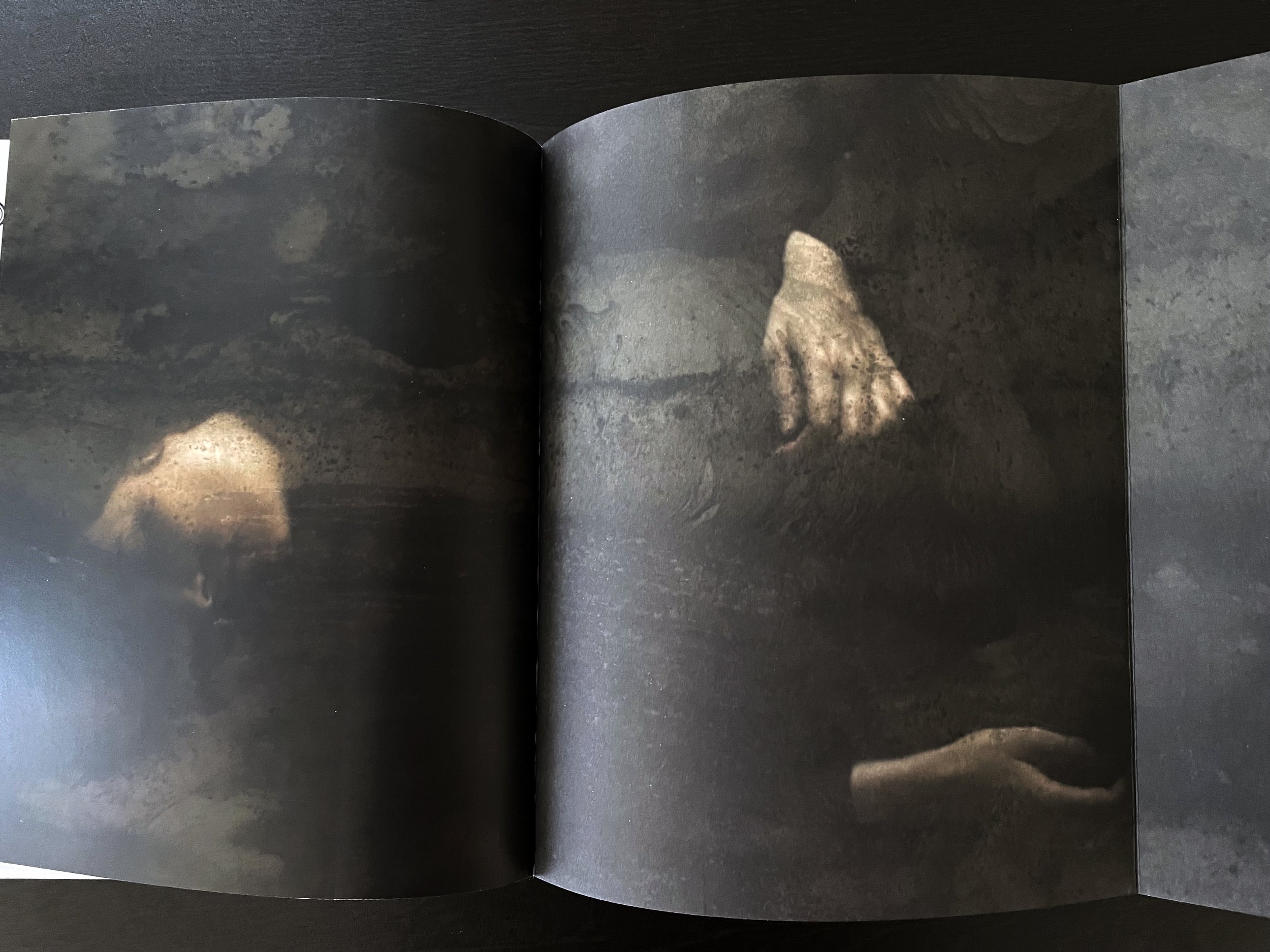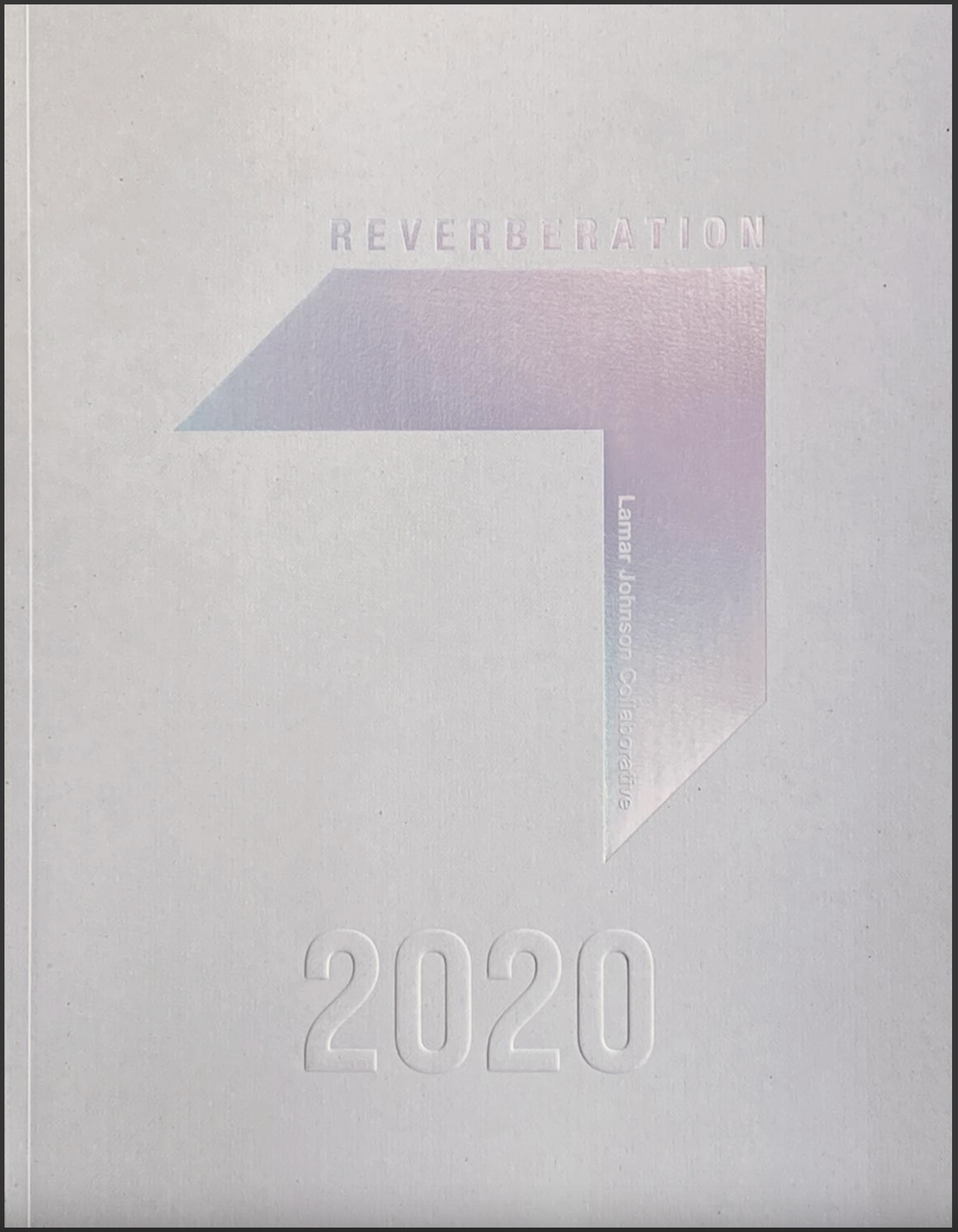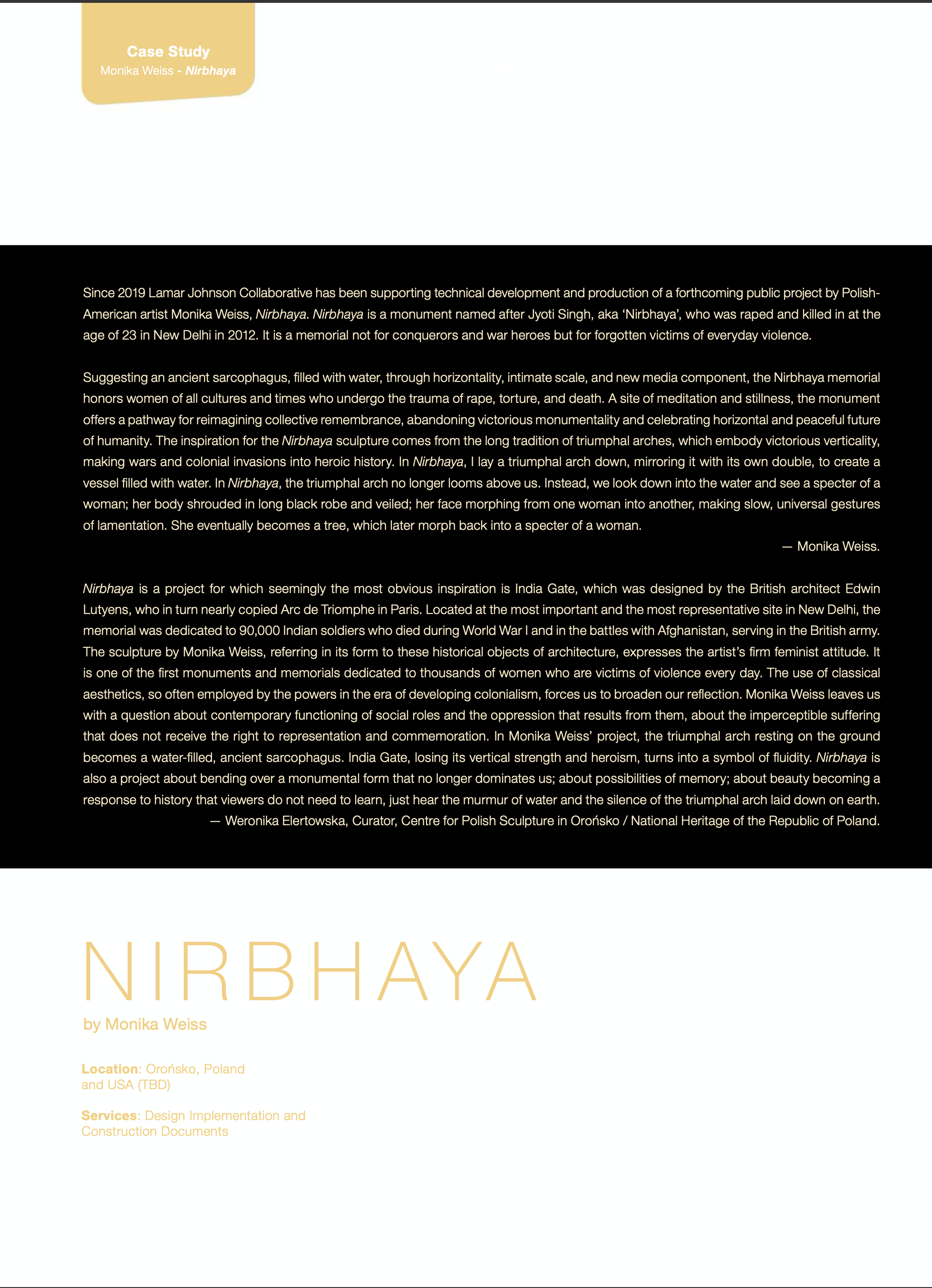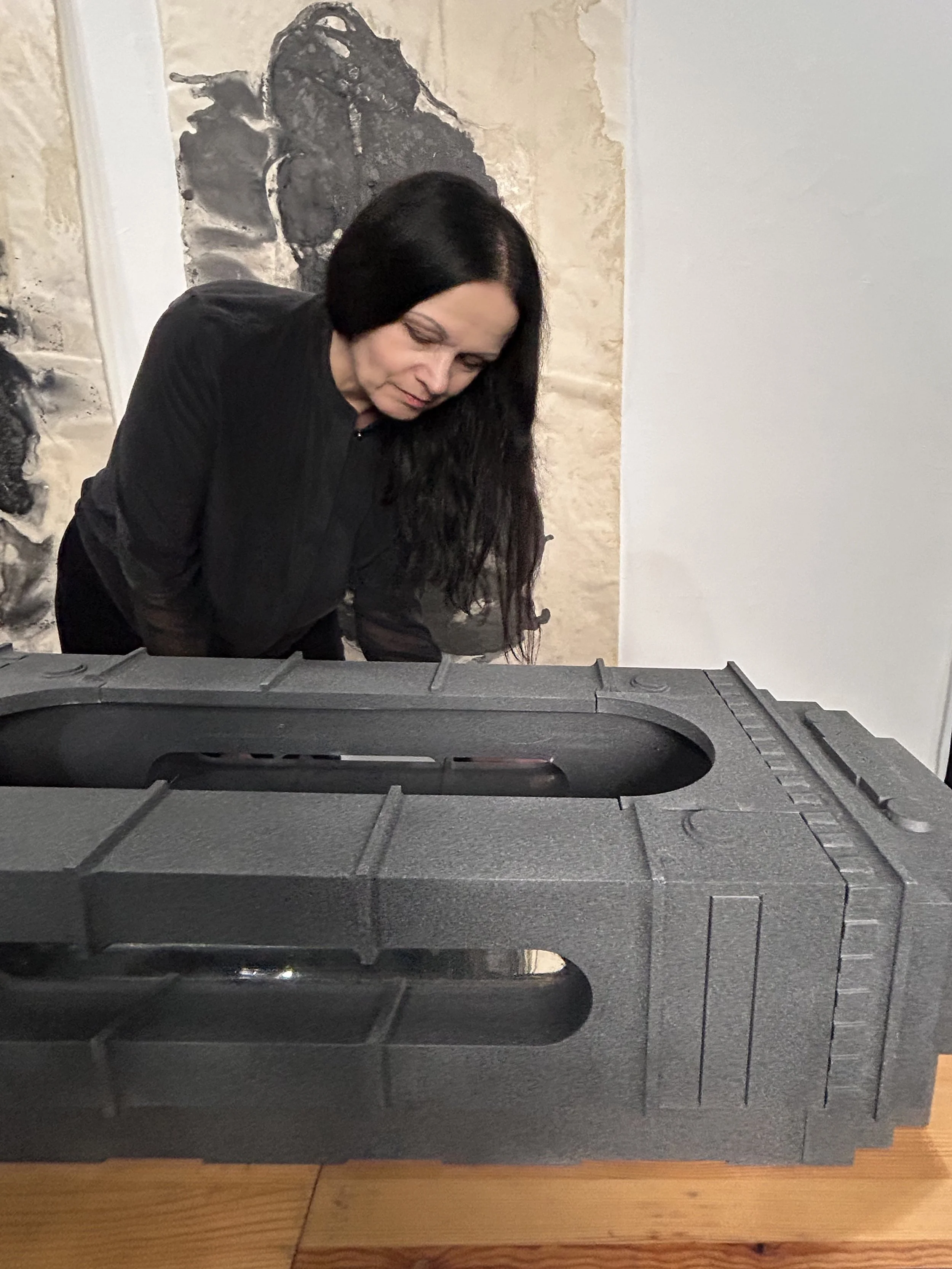Nirbhaya
Monika Weiss, Nirbhaya, rendering of the forthcoming long-term public project
N I R B H A Y A
monument | antimonument
fiberglass, water, digital film, vocal music performances
approximate sculpture dimensions: 6’ x 17’ x 3’
(wersja po polsku poniżej)
Artist Statement
Who is remembered, who is forgotten, and how do we unforget violence, in order to remake a world without it?
The space I hope to create in my art is still. It is about duration. Inside that space time vibrates, resonates. I often call those spaces sites of unforgetting. I try to connect with the mystics who have practiced this knowledge, outside of the confines of language and power structures, across the ages. I invite you to enter those environments. alongside me.
My work - through installation, performance, sound-music, and film - focuses on the body as a vehicle for expression. I choreograph myself and other women, in response to history and memory. I perform slow gestures of lamentation as a poetic expression of resistance to violence and as an expression of solidarity. In my vocal performances, sound-film installations, and sculptures, the protagonists lie silently or stand still and sing wordlessly, in opposition to heroic fantasies of conquest and power.
Nirbhaya is a multidisciplinary public project. It consists of a sculpture resembling an ancient sarcophagus filled with water, an underwater video projection, and an accompanying vocal program. The sculpture is designed to operate independently and survive outdoors, in any metropolitan area, for many years.
Nirbhaya honors women from all cultures and times who experience the trauma of rape, torture, and death. It is a monument dedicated not to conquerors and war heroes, but to the forgotten victims of everyday violence. I named the work "Nirbhaya" in honor of Jyoti Singh, known as "Nirbhaya" (She, the Fearless), who was raped and murdered at the age of 23 in New Delhi in 2012. In this project, all women around the world bear the name Nirbhaya as a gesture of sisterhood and shared power. A site of meditation and stillness, Nirbhaya offers a pathway for reimagining collective remembrance, abandoning victorious monumentality and celebrating the horizontal and peaceful future of humanity.
The formal inspiration for the Nirbhaya sculpture is the traditional form of the triumphal arch, which embodies victorious verticality, transforming wars and colonial invasions into a heroic history. In Nirbhaya, I place a triumphal arch on the ground, mirroring it with its own reflection, creating a vessel filled with water. The triumphal arch no longer hovers above us. Instead, we look down into the water, and within it we see women (an underwater video projection). Wrapped in a long robe, the figures perform slow, universal gestures of lamentation. At certain moments, the figures become trees, alluding to the myth of Daphne.
In the underwater video, through film editing, the women gradually transform from one to the other, becoming one collective body. I continue to choreograph and film women from around the world, both trained actresses and dancers, and those without artistic training who believe in the Nirbhaya concept. I am deeply moved by the generous contributions of so many women from India, Korea, the United States, Poland - and many more places around the world - who continue to participate in the creation of the film portion of the memorial-lament, Nirbhaya. My participants, alongside me, become carriers of anti-colonial memory and agents of meditation toward another, horizontal path to unforgetting. Among them are Priyanka Bhardwaj, Shela Banu, Ruth Blair Moyers, Rosemary Caroll, Vinita DasGupta, Anarya Dodes, Melissa Gollance, Disha Harjani, Katherine Justelle, Jueun Kang, Divya Khandekar, Neha Naraya, Eliana Rowe, and Alexa Velez (partial list).
The silence of the Nirbhaya monument is accompanied by a program of concerts-performances. Vocal pieces will be performed near the sculpture by opera singers and also by singers without musical training. I composed these pieces as songs without words, to evoke the moment in which Daphne, the mythical nymph, escapes rape by transforming into a tree.
Support from my dear friend, New York-based Indian poet Meena Alexander (1951–2018) was invaluable in terms of my understanding of what has happened to Jyoti Singh as well as the cultural and social consequences of what my artistic response to this event may mean. Passages from our transcribed dialogue appear in the newest monograph on my work. Ideas about trauma, healing, transformation, of which we spoke, are foregrounding this project which I since developed. Two lines from Alexander’s poem Moksha, will be engraved on the side of the sculpture:
"Now I hear them sing in low recitative."
- Monika Weiss
Monika Weiss, Nirbhaya, rendering of the forthcoming long-term public project
FINANCIAL SUPPORT
Nirbhaya is a project fiscally sponsored by the New York Foundation for the Arts. Organized in partnership with the New York City Parks Art in the Parks Program and the Streaming Museum, Monika Weiss Nirbhaya is made possible by the New York State Council on the Arts with support from the Office of the Governor and the New York State Legislature. Fundraising is ongoing.
Monika Weiss, Nirbhaya, preparatory drawings
Project Locations
Monika Weiss's Nirbhaya is a long-term, multidisciplinary public project consisting of sculpture, water, underwater video projection, and an accompanying vocal performances program, planned for New York in cooperation with the NYC Parks Art in the Parks Program. A sister project is planned concurrently as part of the permanent collection of Sculpture Park at the Centre of Polish Sculpture in Orońsko.
Public Programs
The public opening of Nirbhaya will include a performance by the artist, involving immersion in the sculpture-sarcophagus. Following the opening, a program of vocal and choral performances will include opera singers and women without musical training, who will perform Monika Weiss's vocal compositions, around the sculpture. These performances will take place several times throughout the project.
Curatorial-Advisory
Since 2018, the Polish location has been curated by Eulalia Domanowska, former CRP director and currently director of the BWA in Sopot, in collaboration with Weronika Elertowska, former CRP curator.
The US location of Nirbhaya project is planed in a public park within New York City. It has been approved and endorsed by NYC Parks. Since 2020 Dag Hammarskjöld Plaza (DHP), located near United Nations headquarters, has been the primary planned location for this long-term public project, DHP is currently undergoing a renovation until the end of 2027.
Long-term public projects exhibited at the DHP are hosted by Sherrill Kazan, President of the World Council of Peoples for the United Nations and President of the Friends of Dag Hammarskjöld Plaza. Since 2020, in collaboration with Sherrill Kazan, the DHP location has been curated by Nina Colosi, Founder and Director of the Streaming Museum.
Since 2024, New York location of Nirbhaya is curated by Izabela Gola, Independent Curator and Visual Arts and Design Curator, Polish Cultural Institute New York.
Since 2024, the Nirbhaya by Monika Weiss Advisory Board is a growing international group of cultural leaders who support the project and its message.
Technical Support
Since 2019, architect Dohyoung Kim and the team at Lamar Johnson Collaborative (LJC) has been supporting the technical development of Monika Weiss's Nirbhaya project. The artist also consulted with engineers and specialists from New York and around the world to design the project in accordance with city standards.
Publications
To date, there have been several publications (in print and online) that focused on Nirbhaya. These include:
*2019, Eulalia Domanowska and Marta Smolińska invite the artist to deliver a lecture and write a text about Nirbhaya for the publication "Sculpture Today IV (Anti-Monument: Non-Traditional Forms of Commemoration)" published by the Centre of Polish Sculpture Center in Orońsko.
*2020, Nina Colosi, Sherrill Kazan, and Shamina de Gonzaga invite Weiss to include the artist’s text about Nirbhaya in CenterpointNow, a publication of the World Council of Peoples for the United Nations. The issue, edited in collaboration with the Streaming Museum, commemorated the 75th anniversary of the founding of the United Nations.
*2021, the Centre of Polish Sculpture in Orońsko (CRP) publishes the largest to date monograph on the artist’s work, Monika Weiss - Nirbhaya, which features texts by the esteemed feminist art historian Griselda Pollock, The Metropolitan Museum of Art Curator of Drawings and Prints Mark McDonald, a conversation between the artist and the poet Meena Alexander, as well as several other texts including essays by Eulalia Domanowska, Kaliopi Minioudaki, Weronika Elertowska, Buzz Spector, Katarzyna Falęcka, and an introduction by CRP dyrektor, Maciej Aleksandrowicz.
*2021, the Centre for Architecture St Louis (CEL) hosts an interdisciplinary symposium Monument|Anti-Monument, inspired by the work of Monika Weiss, Nirbhaya. The symposium includes six virtual panel discussions moderated by New York-based architect Rick Bell and led by CEL director Jasmin Aber. Monika Weiss participated in each panel. The six panels speakers included Michael Arad, Lance Jay Brown, Nina Colosi, Chip Crawford, Eulalia Domanowska, Weronika Elertowska, Wendy Evans Joseph, Katarzyna Falęcka, Vanessa Gravenor and Percy Green, Marianne Hirsch, Lynne Jackson, Walter Johnson, David Lelyveld, Mark McDonald, Tyler Meyr, Gwen Moore, Eric Mumford, Verity Platt, Griselda Pollock, Leila Sadat, Kamala Sankaram, Jeffrey Smith, Buzz Spector, Julia Walker, Krzysztof Wodiczko, and James E. Young.
*2022, Eulalia Domanowska invites Weiss to present her artist text on Nirbhaya as part of the publication Traces of Sisterhood, published by Salon Akademii in Warsaw, Poland in collaboration with TRACTS (Trace as a Research Program for Climate Change, Technology, and Social Justice Studies). The publication accompanies an exhibition of the same title.
Monika Weiss, Nirbhaya Projections, 2020-, stills from 4K digital film, duration variable
Wersja w języku polskim
O kim pamiętamy, o kim zapominamy i jak odzapomnieć przemoc, aby odtworzyć świat bez niej?
Przestrzeń, którą pragnę stworzyć w mojej sztuce, jest nieruchoma. Chodzi o trwanie. W tej przestrzeni czas wibruje, rezonuje. Często nazywam te przestrzenie miejscami odzapomnienia. Staram się połączyć z mistykami, którzy praktykują tę wiedzę, poza ograniczeniami języka i struktur władzy, poprzez wieki. Zapraszam Was do wejścia w te przestrzenie. razem ze mną.
Moja twórczość - poprzez instalacje, performansie, dźwięk-muzykę i film - koncentruje się na ciele jako nośniku ekspresji. Komponuję choreografię dla siebie i dla innych kobiet w odpowiedzi na historię i pamięć. Wykonuję gesty powolnego lamentu jako poetycki wyraz sprzeciwu wobec przemocy a także jako wyraz solidarności. W moich performansach wokalnych, instalacjach dźwiękowo-filmowych, rysunkach i rzeźbach, bohaterki leżą w ciszy lub stoją nieruchomo i śpiewają bez słów, sprzeciwiając się heroicznym fantazjom o podboju i władzy.
Nirbhaya to multidyscyplinarny projekt publiczny. Składa się z rzeźby przypominającej starożytny sarkofag wypełniony wodą, podwodnej projekcji wideo oraz towarzyszącego programu wokalnego. Rzeźba została zaprojektowana tak, aby działać niezależnie i przetrwać na zewnątrz, w dowolnym obszarze metropolitalnym, przez wiele lat.
Nirbhaya oddaje hołd kobietom ze wszystkich kultur i czasów, które doświadczają traumy gwałtu, tortur i śmierci. To pomnik nie dla zdobywców i bohaterów wojennych, lecz dla zapomnianych ofiar codziennej przemocy. ANadałam pracy nazwę „Nirbhaya” na cześć Jyoti Singh, znanej jako „Nirbhaya” (Ona, Nieustraszona), która została zgwałcona i zamordowana w wieku 23 lat w Nowym Delhi w 2012 roku. W tym projekcie wszystkie kobiety na całym świecie noszą imię Nirbhaya, jako gest siostrzeństwa i wspólnej mocy. Nirbhaya, miejsce medytacji i ciszy, oferuje drogę do ponownego wyobrażenia sobie zbiorowej pamięci, porzucenia zwycięskiej monumentalności i celebrowania horyzontalnej i pokojowej przyszłości ludzkości.
Formalną inspiracją dla rzeźby Nirbhaya jest tradycyjna forma łuku triumfalnego, który ucieleśnia zwycięską wertykalność, przemieniając wojny i najazdy kolonialne w heroiczną historię. W Nirbhayi kładę łuk triumfalny na ziemi, odzwierciedlając go swoim własnym odbiciem, tworząc naczynie wypełnione wodą. Łuk triumfalny nie unosi się już nad nami. Zamiast tego, spoglądamy w dół, w wodę, a w niej widzimy kobietę (podwodna projekcja wideo). Spowite długą szatą, postaci te wykonują powolne, uniwersalne gesty lamentacji. W pewnych momentach postaci stają się drzewami, co nawiązuje do mitu Dafne.
W podwodnym wideo, dzięki montażowi filmowemu, kobiety stopniowo przekształcają się z jednej w drugą, stając się jednym kolektywnym ciałem. Kontynuuję choreografie i filmuję kobiety z całego świata, zarówno wyszkolone aktorki i tancerki, jak i osoby bez wykształcenia artystycznego, które wierzą w ideę Nirbhayi. Jestem głęboko poruszona hojnym wkładem tak wielu kobiet z Indii, Korei, Stanów Zjednoczonych, Polski - i wielu innych miejsc na świecie - które uczestniczą w tworzeniu filmowej części pomnika-lamentu Nirbhaya. Moje uczestniczki stają się, wraz ze mną, nosicielkami antykolonialnej pamięci i ucieleśnieniem medytacji ku innej, horyzontalnej drodze do odzapomnienia. Wśród nich są Priyanka Bhardwaj, Shela Banu, Ruth Blair Moyers, Rosemary Caroll, Vinita DasGupta, Anarya Dodes, Melissa Gollance, Disha Harjani, Katherine Justelle, Jueun Kang, Divya Khandekar, Neha Naraya, Eliana Rowe i Alexa Velez (lista częściowa).
Ciszy pomnika Nirbhaya towarzyszy program koncertów-performancsów. Utworów wokalne będą wykonane w pobliżu rzeźby przez wokalistki operowe ale także śpiewaczki bez wykształcenia muzycznego. Skomponowałam te utwory jako pieśni bez słów, aby przywołać moment, w którym Dafne, mityczna nimfa, ucieka przed gwałtem, przemieniając się w drzewo.
Wsparcie mojej drogiej przyjaciółki, indyjskiej poetki Meeny Alexander (1951–2018), było nieocenione, jeśli chodzi o zrozumienie tego, co stało się z Jyoti Singh, a także kulturowych i społecznych konsekwencji mojej artystycznej reakcji na to wydarzenie. Fragmenty z naszego zapisanego dialogu pojawiają się w najnowszej monografii poświęconej mojej twórczości. Idee dotyczące traumy, uzdrowienia i transformacji, o których rozmawialiśmy, wysuwają się na pierwszy plan tego projektu, który od tamtej pory rozwijam. Na boku rzeźby zostaną wygrawerowane dwa wersy z wiersza Meeny Alexander, „Moksha”:
„Teraz słyszę, jak śpiewają niskim recytatywem”.
- Monika Weiss
Wsparcie finansowe
Nirbhaya to projekt finansowany fiskalnie przez New York Foundation for the Arts (NYFA). Zorganizowana we współpracy z programem Art in the Parks w New York City Parks oraz Streaming Museum, Monika Weiss-Nirbhaya jest możliwa dzięki New York State Council on the Arts przy wsparciu Biura Gubernatora i Legislatury Stanu Nowy Jork. Zbiórka funduszy jest w toku.
Lokalizacje projektu
Nirbhaya Moniki Weiss to długoterminowy, multidyscyplinarny projekt publiczny, składający się z rzeźby wypełnionej wodą, podwodnej projekcji wideo - oraz towarzyszącego jej programu wokalnego - zaplanowany w Nowym Jorku we współpracy z programem NYC Parks Art in the Parks Program. Równocześnie planowana jest instalacja siostrzanego projektu w ramach stałej kolekcji Parku Rzeźby, Centrum Rzeźby Polskiej w Orońsku.
Programy publiczne
Publiczne otwarcie Nirbhayi obejmie performans artystki, polegający na zanurzeniu się w rzeźbie-sarkofagu. Po otwarciu, program występów wokalno-chóralnych włączy śpiewaczki operowe a także kobiety bez muzycznego wykształcenia. Kilkakrotnie w trakcie trwania projektu, zaśpiewane bez słów kompozycje wokalne Moniki Weiss, będą wykonane wokół rzeźby,
Kuratorstwo-Doradctwo
Jedną z lokalizacji omawianych z NYC Parks jest Dag Hammarskjöld Plaza (DHP), który obecnie przechodzi renowację. Projekty wystawiane w DHP są organizowane przez Sherrill Kazan, Prezeska Światowej Rady Ludów ONZ i Prezeska Stowarzyszenia Przyjaciół Placu Daga Hammarskjölda. Od 2019 roku kuratorką projektu w DHP jest Nina Colosi, założycielka i dyrektorka Streaming Museum we współpracy z Sherrill Kazan. Od 2024 roku program projektu w DHP jest kuratorowany przez Izabelę Golę, niezależną kuratorkę i kuratorkę sztuk wizualnych i designu w Instytucie Kultury Polskiej w Nowym Jorku. Od 2018 roku kuratorką projektu w Centrum Rzeźby Polskiej w Orońsku była Eulalia Domanowska, uprzednio dyrektorka Centrum Rzeźby Polskiej w Orońsku (CRP), a obecnie dyrektorka BWA w Sopocie, we współpracy z Weroniką Elertowską, byłą kuratorką w CRP. Monika Weiss - Nirbhaya Rada Doradcza to rozwijająca się międzynarodowa grupa przedstawicieli kultury, którzy wspierają projekt i jego przesłanie.
Wsparcie techniczne
Od 2019 roku Dohyoung Kim oraz zespół Lamar Johnson Collaborative (LJC) wspiera rozwój techniczny projektu Nirbhaya autorstwa Moniki Weiss. Artystka konsultowała się także z inżynierami i specjalistami z Nowego Jorku i z całego świata, aby zaprojektować projekt zgodnie ze standardami miasta.
PUBLIKACJE
Publikacje o projekcie włączają:
*2019, Eulalia Domanowska i Marta Smolińska zaprosiły artystkę do napisania tekstu na temat Nirbhayi w ramach publikacji „Rzeźba dzisiaj IV (Anty-pomnik. Nietradycyjne formy upamiętnienia)”, Centrum Rzeźby Polskiej w Orońsku.
*2020, Nina Colosi, Sherrill Kazan i Shamina de Gonzaga zaprosiły Weiss do opublikowania jej tekstu o Nirbhayi w CenterpointNow, wydawnictwie Światowej Rady Ludów ONZ. Wydanie, redagowane we współpracy ze Streaming Museum, upamiętniło 75. rocznicę powstania Organizacji Narodów Zjednoczonych.
*2021, Centrum Rzeźby Polskiej w Orońsku opublikowało największą jak dotąd monografię o twórczości artystki, Monika Weiss – Nirbhaya, w której znalazły się teksty cenionej feministycznej historyczki sztuki Griseldy Pollock, kuratora rysunku i grafiki w The Metropolitan Museum of Art Marka McDonalda, rozmowa artystki z poetką Meeną Alexander, a także kilka innych tekstów, w tym eseje Eulalii Domanowskiej, Kaliopi Minioudaki, Weroniki Elertowskiej, Buzza Spectora, Katarzyny Falęckiej oraz wstęp dyrektora CRP Macieja Aleksandrowicza.
*2021, Centrum Architektury St. Louis CEL zorganizowało interdyscyplinarne sympozjum „Monument|Anti-Monument”, inspirowanych pracą Moniki Weiss Nirbhaya. Sympozjum składało się z sześciu wirtualnych paneli dyskusyjnych moderowanych przez nowojorskiego architekta Ricka Bella i prowadzonych przez dyrektorkę CEL Jasmin Aber. W każdym panelu uczestniczyła Monika Weiss. Prelegenci włączyli następujące osoby: Michael Arad, Lance Jay Brown, Nina Colosi, Chip Crawford, Eulalia Domanowska, Weronika Elertowska, Wendy Evans Joseph, Katarzyna Falęcka, Vanessa Gravenor i Percy Green, Marianne Hirsch, Lynne Jackson, Walter Johnson, David Lelyveld, Mark McDonald, Tyler Meyr, Gwen Moore, Eric Mumford, Verity Platt, Griselda Pollock, Leila Sadat, Kamala Sankaram, Jeffrey Smith, Buzz Spector, Julia Walker, Krzysztof Wodiczko i James E. Young.
*2022, Eulalia Domanowska zaprosiła Weiss do zaprezentowania tekstu artystki o Nirbhayi w publikacji „Ślady Siostrzeństwa”, wydanej przez Salon Akademii w Warszawie we współpracy z TRACTS (Ślad jako program badawczy dla zmian klimatu, badań nad technologią i sprawiedliwością społeczną).
Monika Weiss, Nirbhaya, 5:1 model of the sculpture in the artist Brooklyn studio, photographed by Izabela Gola




